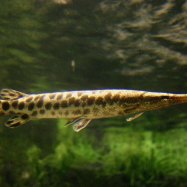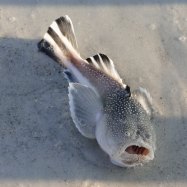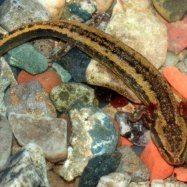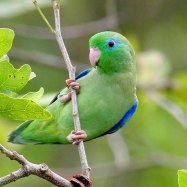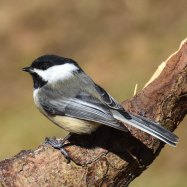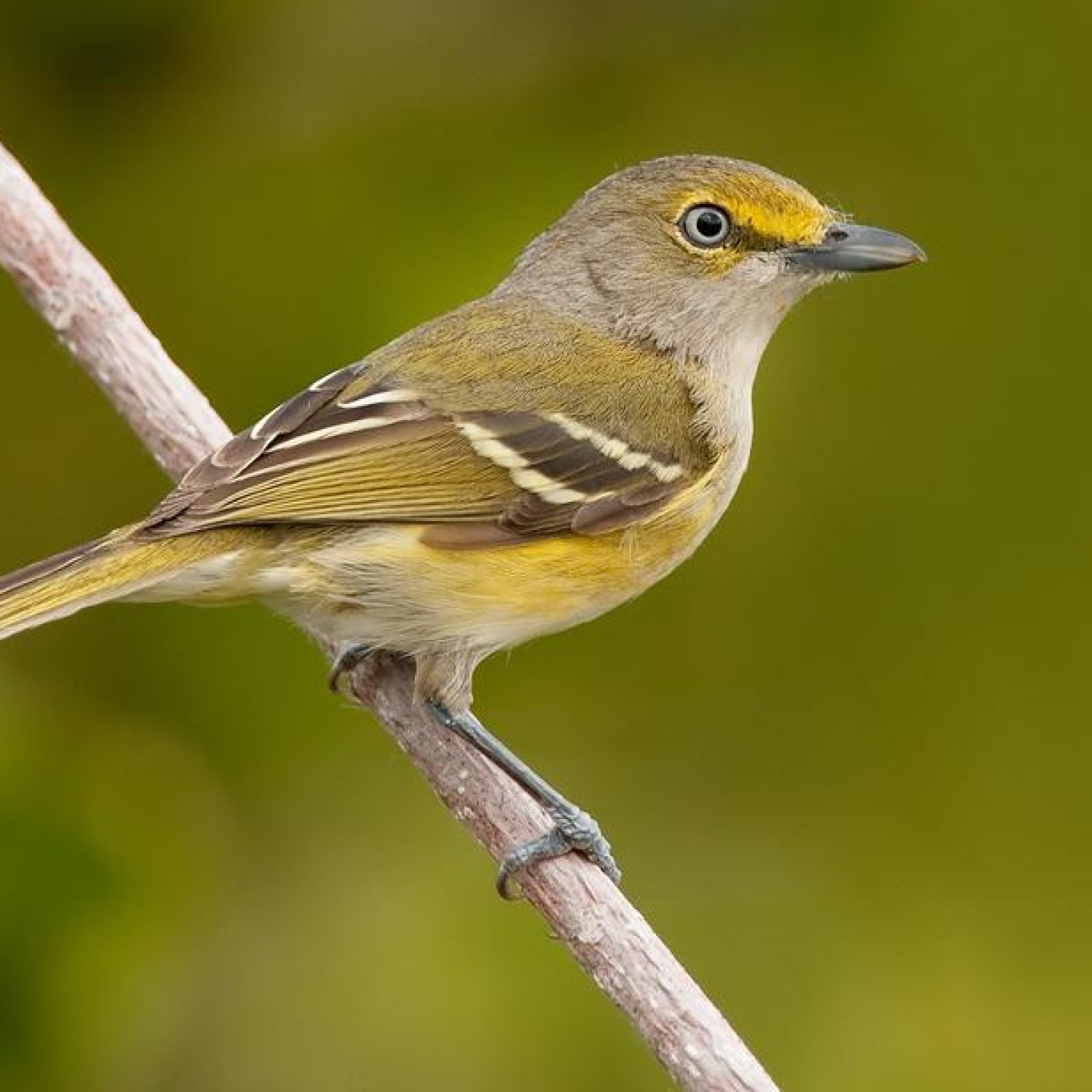
White Eyed Vireo
11-12.5 cm
The White Eyed Vireo is a charming small-sized songbird found in North America. With a length of 11-12.5 cm, these birds have distinct white eyes and belong to the Vireonidae family. They have a wonderful melodious song and can be spotted in brushy areas, making them a delight for birdwatchers. #WhiteEyedVireo #Vireonidae #NorthAmerica #songbird
Animal Details Summary:
Common Name: White Eyed Vireo
Kingdom: Animalia
Habitat: Woodlands, shrubby areas, thickets, and forest edges
The Chirpy White Eyed Vireo: Small Yet Mighty in the World of Birds
From the lush woodlands and thickets of eastern and central United States to the sun-kissed lands of Mexico, a small yet mighty creature can be heard singing its heart out. Meet the White Eyed Vireo, also known by its scientific name, Vireo griseus. This charming bird with its vibrant olive-green feathers and white eye-ring may seem unassuming at first glance, but don't let its small size fool you. The White Eyed Vireo is an insectivorous powerhouse and a beloved addition to North America's diverse avian population White Eyed Vireo.An Overview of the White Eyed Vireo
Belonging to the Kingdom Animalia and the Phylum Chordata, the White Eyed Vireo falls under the Class Aves, also known as birds. It is a member of the Passeriformes order and the Vireonidae family, making it a distant relative of the more recognizable songbirds like the sparrows and finches.As its name suggests, the White Eyed Vireo's most prominent feature is its white eye-ring, which starkly contrasts its olive-green feathers. The bird's small size, ranging from 11-12.5 cm in length, makes it one of the smallest songbirds in North America. But what it lacks in size, it makes up for in its powerful and melodious singing voice.
Habitat and Distribution
The White Eyed Vireo is a migratory bird that can be found in various habitats throughout its range. Its preferred habitat includes woodlands, shrubby areas, thickets, and forest edges. These areas provide the bird with plenty of insects, its primary source of food Woolly Monkey.Its geographical distribution spans across the eastern and central United States, from the southern parts of New York to the Gulf Coast of Texas. It can also be found in Mexico, making it a resident of North America.
A Mighty Insectivore
Despite its small size and gentle appearance, the White Eyed Vireo is a relentless insect hunter. With its sharp beak and agile movements, it can quickly catch insects on the wing or from the safety of thick foliage. Its diet is primarily composed of small insects, such as caterpillars, beetles, flies, and spiders.White Eyed Vireos are known to be vocal while foraging for food. Their unique songs and calls can often be heard as they hunt for their next meal. This behavior serves two purposes – to attract mates and to communicate with others of the same species.
Country of Origin: United States
As a migratory bird, the White Eyed Vireo may be found in Mexico during the winter months. However, its country of origin is the United States, where it nests and breeds during the spring and summer.In the United States, the White Eyed Vireo can be found in several states, including New York, Pennsylvania, Oklahoma, and most of the southern states. It is a common sight in these regions, and bird enthusiasts often wait for its arrival eagerly.
North America's Little Songbird
The White Eyed Vireo is characterized by its small size and relatively unremarkable appearance compared to other birds. But what sets it apart from the rest is its musical abilities. It is known for its loud, clear, and complex songs, which it sings to defend its territory and attract a mate.In a world dominated by the showy and colorful birds, the White Eyed Vireo stands out for its vocal prowess. Its song, which has been described as a "chattering, bubbly, and cheerful warble," is often a familiar sound in the eastern and central United States.
Adaptable and Resilient
One of the reasons for the White Eyed Vireo's widespread presence is its adaptability. This bird can thrive in different environments, including open fields, woodland edges, and even suburban areas. It is a tough and resilient species, able to withstand habitat changes and human influence to some extent.However, like many other species of birds, the White Eyed Vireo is facing threats such as habitat loss, climate change, and human disturbance. This has resulted in declining populations in some areas, making conservation efforts crucial for the survival of this delightful songbird.
The White Eyed Vireo in Literature and Culture
The White Eyed Vireo may not be the most well-known bird, but it has captured the attention of literary figures and artists over the years. In the poem "A Sweet Heart of Youth," American poet Ralph Waldo Emerson mentions the bird as a joyful songster.In the book "My Side of the Mountain" by Jean Craighead George, the protagonist Sam Gribley develops a special bond with a white-eyed vireo he names "Lady." The bird serves as a companion to Sam during his time in the wilderness.
The White Eyed Vireo has also been featured on postage stamps, showcasing its significance and impact on popular culture.
In Conclusion
In a world of flashy, eye-catching birds, the White Eyed Vireo may not stand out at first glance. But upon closer inspection, this small yet mighty songbird reveals its true beauty in its vocal abilities, adaptability, and resilience. As a vital part of North America's ecosystem, the White Eyed Vireo deserves our attention and protection. So next time you find yourself in the woodlands of the eastern or central United States, keep an ear out for the sweet and cheerful warble of this charming little bird.

White Eyed Vireo
Animal Details White Eyed Vireo - Scientific Name: Vireo griseus
- Category: Animals W
- Scientific Name: Vireo griseus
- Common Name: White Eyed Vireo
- Kingdom: Animalia
- Phylum: Chordata
- Class: Aves
- Order: Passeriformes
- Family: Vireonidae
- Habitat: Woodlands, shrubby areas, thickets, and forest edges
- Feeding Method: Insectivorous
- Geographical Distribution: Eastern and Central United States, and Mexico
- Country of Origin: United States
- Location: North America
- Animal Coloration: Olive-green
- Body Shape: Small-sized songbird
- Length: 11-12.5 cm
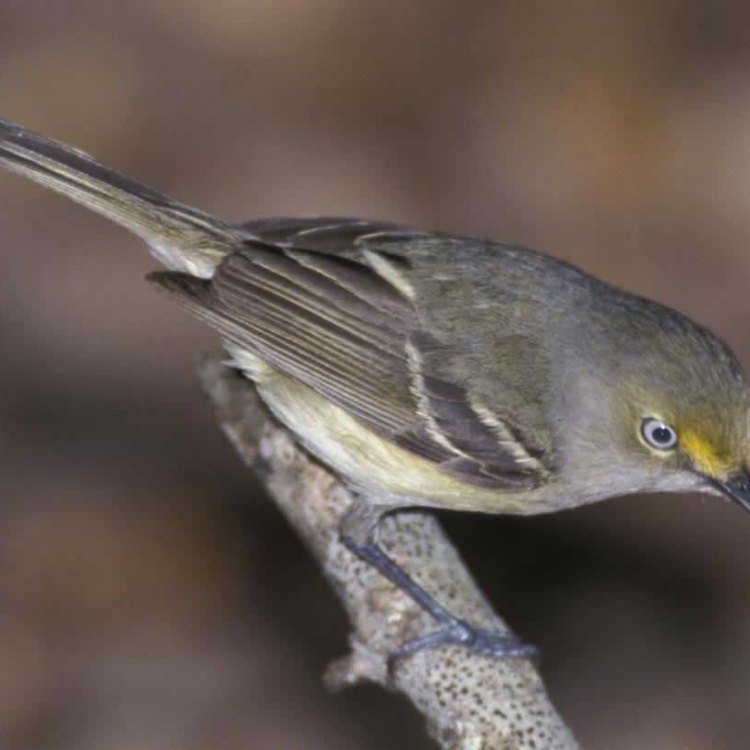
White Eyed Vireo
- Adult Size: Small - medium
- Average Lifespan: 3-4 years
- Reproduction: Biparental
- Reproductive Behavior: Monogamous
- Sound or Call: Distinctive song with various whistles, phrases, and mimicry of other bird species
- Migration Pattern: Short-distance migrant or resident
- Social Groups: Solitary or in small groups
- Behavior: Energetic and active; frequently flicks wings and tail
- Threats: Habitat loss, pesticide use, nest predation
- Conservation Status: Least Concern
- Impact on Ecosystem: Pollinates flowers and controls insect populations
- Human Use: Popular bird for birdwatching and bird photography
- Distinctive Features: White iris, olive-green coloration, white spectacles
- Interesting Facts: The White-eyed Vireo is known for its unique song that sounds like 'Cheer up, cheerily, cheer up!'
- Predator: Small mammals, snakes, birds of prey
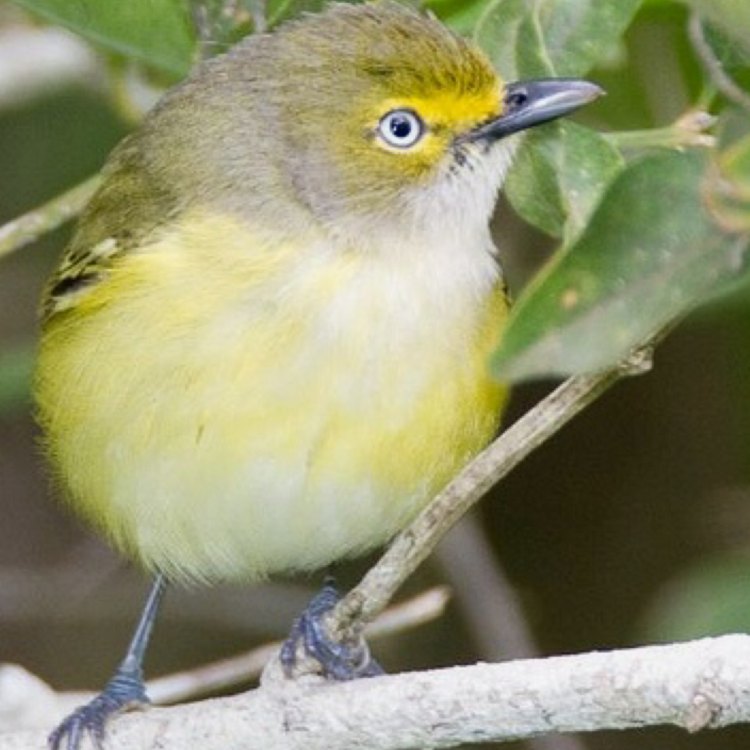
Vireo griseus
The Energetic and Unique White-Eyed Vireo: An Unsung Hero of the Avian World
When you think of colorful and melodious birds, the flashy peacock or the talented nightingale may come to mind. However, there is one small bird that is often overlooked but deserves a spotlight of its own – the White-eyed Vireo.Known for its striking olive-green coloration, white spectacles, and distinctive song, the White-eyed Vireo is a small but mighty bird found in various parts of North and Central America. Its scientific name, Vireo griseus, translates to "grayish-green bird," which is a perfect description of its appearance PeaceOfAnimals.Com.
But there is much more to this bird than just its appearance. With its unique features and behavior, the White-eyed Vireo has an important role in the ecosystem and a fascinating story to tell.
A Little Bird with a Big Personality
The White-eyed Vireo is a small to medium-sized bird, measuring around 4-5 inches in length with a wingspan of about 7-9 inches. Despite their small size, they are quite energetic and active birds, frequently flicking their wings and tail while foraging for food.They can be found in a variety of habitats, such as open woods, thickets, and shrubby areas. They are not shy birds and can be easily spotted as they hop from branch to branch or sing their hearts out from the treetops.
While they may be solitary or in small groups, during the breeding season, they are known to form monogamous pairs and raise their young together. This biparental reproductive behavior is a unique trait that sets them apart from many other bird species.
A Concerto of Whistles, Phrases, and Mimicry
When it comes to mating and territory disputes, birds often rely on their songs to communicate White Faced Capuchin. The White-eyed Vireo's song is distinct and intricate, with a range of whistles, phrases, and even mimicry of other bird species.Their song has been described as a cheerful and bubbly "Cheer up, cheerily, cheer up!" which is how they earn their nicknames, the "cheery-bird" and "White-eyed Vireo." This unique song not only sets them apart from other birds but also helps them attract a mate and defend their territory.
But their impressive vocal abilities don't just stop there. During the breeding season, male White-eyed Vireos also perform a "wing flicking" behavior while singing. This involves rapidly flicking their wings horizontally, often synchronized with their vocalizations. This action is believed to attract female vireos and also serves as a visual display to defend their territory.
A Short-Distance Migrant or Resident
Unlike many other birds that undertake long and tedious journeys for migration, the White-eyed Vireo's migrations are relatively short. They are considered to be a short-distance migrant, traveling up to 600 miles to southern parts of the United States during the winter.However, some populations are known to be residents, meaning they do not migrate and can be found in the same area year-round. This adaptability of migration patterns is a valuable skill for survival, especially in changing climates.
A Story of Survival
The White-eyed Vireo may have a seemingly sweet and carefree existence, but like many other bird species, they face various threats in the wild. Habitat loss due to human development, pesticide use, and competition for resources with invasive species are among the major challenges they face.Additionally, their nests are at risk of being preyed upon by snakes, small mammals, and birds of prey. With an average lifespan of only 3-4 years, these birds have to constantly face these threats and fight for survival.
Fortunately, the White-eyed Vireo's population is currently stable, and they are listed as "Least Concern" on the International Union for Conservation of Nature (IUCN) Red List. However, continued conservation efforts and awareness are crucial to ensure their long-term survival.
The White-Eyed Vireo - An Unsung Hero of the Ecosystem
Apart from their beautiful songs and unique behaviors, the White-eyed Vireo also plays a vital role in the ecosystem. As insectivorous birds, they help control insect populations, making them an essential component of a healthy ecosystem.Moreover, they also contribute to pollination, as they feed on nectar and help disperse pollen from flower to flower. Without these tiny helpers, many plant species could struggle to reproduce and survive.
A Popular Bird for Birdwatching and Bird Photography
While the White-eyed Vireo may not be as well-known as other bird species, it is a popular bird for birdwatching and bird photography. With its striking appearance and distinctive song, it's no wonder that many birders and photographers are drawn to this small but mighty bird.Whether it's capturing their wing flicking behaviors, unique songs, or getting a close-up of their white irises, the White-eyed Vireo is a treat for bird lovers and photographers alike.
In Conclusion
The White-eyed Vireo may be small in size, but it has a big personality and an important role in the ecosystem. From their energetic and active behavior to their distinctive songs and unique features, they have captivated the hearts of bird enthusiasts and have a story worth telling.While they may face various threats in the wild, their adaptability and resilience have helped them survive. With conservation efforts and awareness, we can ensure that the White-eyed Vireo continues to cheer up the world with their beautiful songs for generations to come. So, the next time you hear a joyful "Cheer up, cheerily, cheer up!" in the woods, take a moment to appreciate the unsung hero behind that tune – the White-eyed Vireo.
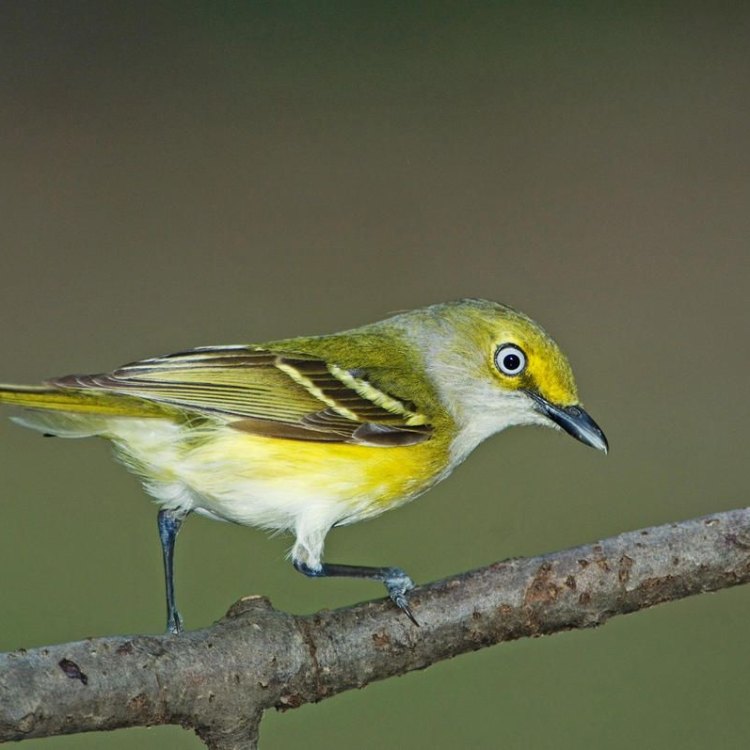
The Chirpy White Eyed Vireo: Small Yet Mighty in the World of Birds
Disclaimer: The content provided is for informational purposes only. We cannot guarantee the accuracy of the information on this page 100%. All information provided here may change without prior notice.


